The Bank of Canada (BoC) is expected to hold rates at the current 1.75% setting on Wednesday. Recent upbeat economic data has sharply curtailed chances for a rate cut. The labour market remains firm, while activity in the housing market is picking up, businesses see moderate sales growth going forward and core inflation is running near the 2% target. Granted, GDP is on track to slow in Q3 and Q4 relative to the robust Q2 growth performance, but a slowing in the second half is well anticipated by the BoC.
And while the “trade war” remains elevated — negative impacts are evident in investment and exports — the flow of economic data as a whole suggests the current level of policy accommodation is sufficient for now.
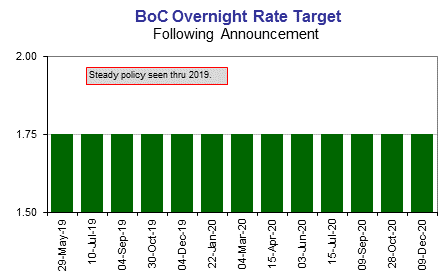
The BoC’s Outlook Survey further solidified the case for no rate change at the October 30 announcement alongside the retention of a wait and see approach to policy that is driven by the data.
The survey revealed that business sentiment improved slightly in Q3 from Q2. Investment and hiring plans are “healthy” outside of energy producing regions. The share of firms reporting pressures on production capacity and/or reporting labour shortages are at somewhat elevated levels.
The majority of firms continue to project inflation to be in the lower half of the BoC’s inflation control range. The future sales indicator points to “modest” sales growth ahead. The Business Outlook Indicator improved to 0.4 from -0.1. With the labour market humming along (unemployment is holding near a 40-year low) and the outlook survey consistent with modest growth, there is little support from the data for a near term rate cut.
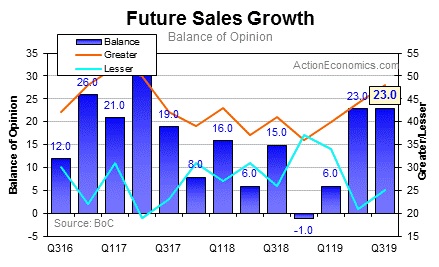
Total employment grew 53.7k in September after the 81.1k surge in August, leaving two months of robust job growth that came in well above expectations. The unemployment rate fell to 5.5% in September from 5.7% in August.
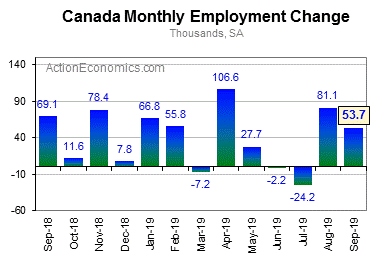
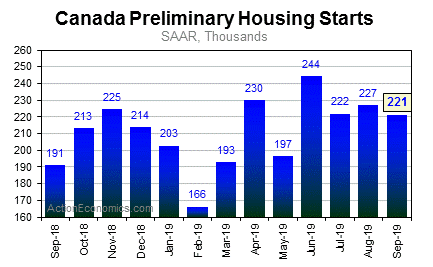
Canada’s housing market has picked-up after a weak start to the year, aided by lower mortgage rates and the strong employment backdrop.
The monthly GDP report is tracking a slowing in Q3 GDP, but to a 1.7% pace (q/q, saar) that would come in marginally above the BoC’s 1.5% estimate. The wholesale shipment drop injected fresh downside risk to August GDP, but did not alter the outlook for no change in policy from the BoC. However, gains in manufacturing, retail sales and housing starts are supportive of a return to growth in August after the flat reading (0.0%) in July. Moreover, temporary shutdowns in oil and gas extraction restrained GDP growth in July — a return to more typical production levels should provide a boost in August.
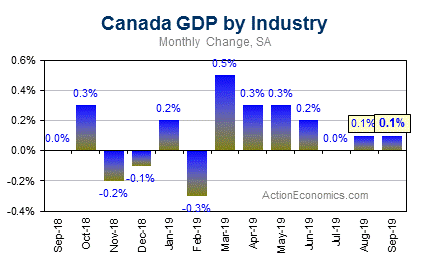
The economic data make a solid case for steady policy from the BoC next week and through year end. Notably, market expectations for a rate cut in the near term have been trimmed in recent weeks as firm data accumulates and optimism rises on the US-Sino trade front and Brexit front.
While the BoC has been clear that data is the driver of central bank policy, it would be remiss not to acknowledge that the BoC could adopt the Fed’s mid-cycle adjustment approach amid ongoing global uncertainty that is having a clear negative impact on Canada’s exports and business investment.
Click here to access the HotForex Economic calendar.
Andria Pichidi
Market Analyst
Disclaimer: This material is provided as a general marketing communication for information purposes only and does not constitute an independent investment research. Nothing in this communication contains, or should be considered as containing, an investment advice or an investment recommendation or a solicitation for the purpose of buying or selling of any financial instrument. All information provided is gathered from reputable sources and any information containing an indication of past performance is not a guarantee or reliable indicator of future performance. Users acknowledge that any investment in Leveraged Products is characterized by a certain degree of uncertainty and that any investment of this nature involves a high level of risk for which the users are solely responsible and liable. We assume no liability for any loss arising from any investment made based on the information provided in this communication. This communication must not be reproduced or further distributed without our prior written permission.



















